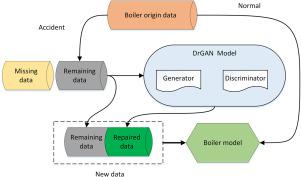Applied Soft Computing ( IF 7.2 ) Pub Date : 2021-02-24 , DOI: 10.1016/j.asoc.2021.107214 Xiaobin Hu , Guoqiang Li , Peifeng Niu , Jianmei Wang , Linlin Zha

|
Many achievements have been made in using neural networks to predict complex nonlinear industrial activities. The assumption that these prediction models established is that the various data collected by the sensors are available and accurate. However, accidents always happen beyond assumptions. The interference and damage of sensors are common phenomena in actual industrial production. In this case, the data collected by the sensors is incorrect and unavailable and cannot be fed into the prediction model for work. Incorrect data leads to inaccurate predictions, and the predictions lead to incorrect actions, which ultimately affect the activities of the entire industrial assembly line. How is this kind of problem data dealt with? This is the first time that generative adversarial networks (GAN) technology has been used to repair missing boiler data. Although GAN technology was originally used for image processing, we took the lead in transferring this technology to the issue of boiler data repair. Furthermore, we proposed a novel model structure that is more suitable for boiler data repair. Our method has rigorous theoretical feasibility and has passed the experimental test.
中文翻译:

工业锅炉数据修复的生成对抗神经网络模型
在使用神经网络预测复杂的非线性工业活动方面取得了许多成就。建立这些预测模型的假设是,传感器收集的各种数据均可用且准确。但是,事故总是会发生超出预期的情况。传感器的干扰和损坏是实际工业生产中的普遍现象。在这种情况下,传感器收集的数据不正确且不可用,无法将其输入到预测模型中进行工作。错误的数据会导致不正确的预测,而预测会导致错误的操作,最终会影响整个工业装配线的活动。这种问题数据如何处理?这是第一次使用生成对抗网络(GAN)技术来修复丢失的锅炉数据。尽管GAN技术最初用于图像处理,但我们还是率先将该技术转移到锅炉数据修复问题上。此外,我们提出了一种更适合锅炉数据修复的新型模型结构。我们的方法具有严格的理论可行性,并通过了实验测试。











































 京公网安备 11010802027423号
京公网安备 11010802027423号